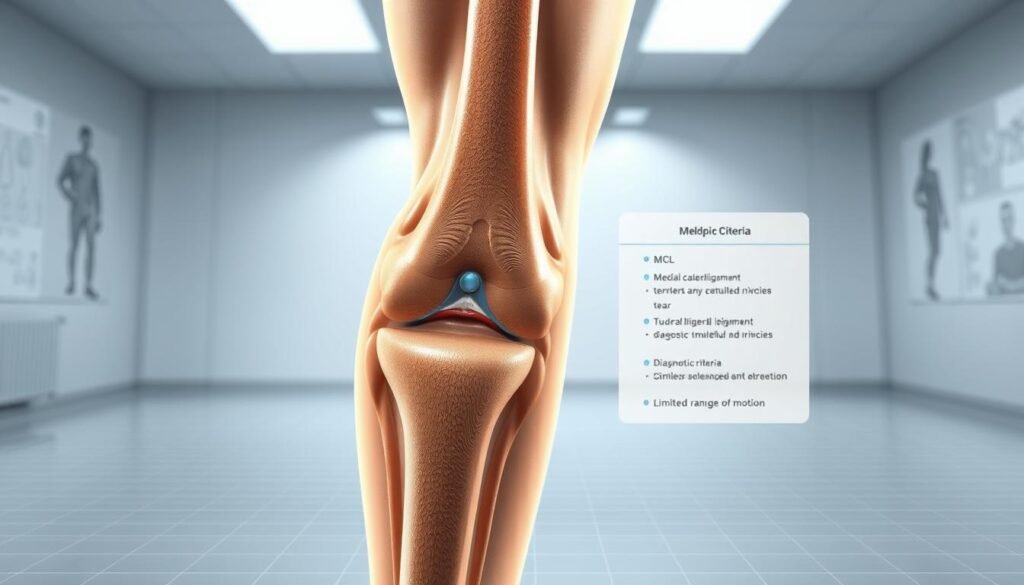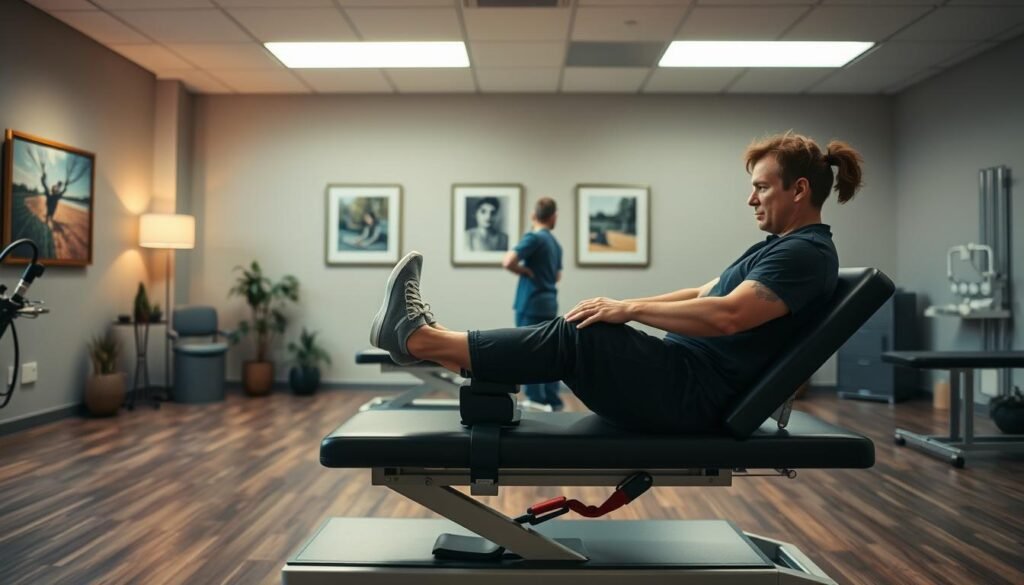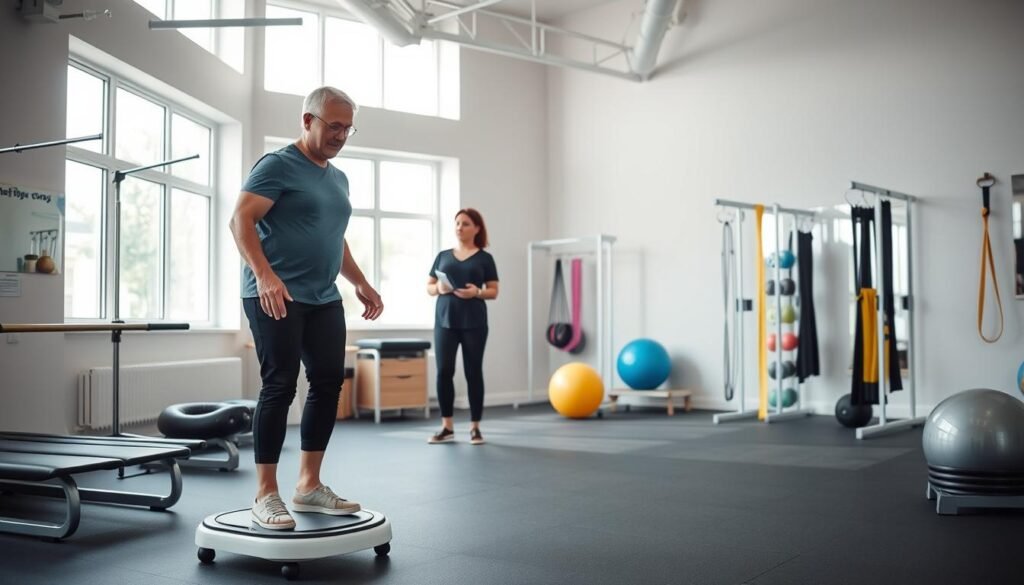
When your joint stability feels compromised, how do you separate fact from fiction in rehabilitation? Knee injuries disrupt lives—whether you’re pivoting on a field or climbing stairs. The medial collateral ligament, a critical stabilizer, suffers damage more often than people realize. Yet myths about “resting it out” or rushing back to activity persist.
We’ve designed this guide to cut through confusion. While the knee is vulnerable during high-impact movements, structured care makes full recovery achievable. Our approach prioritizes restoring mobility without compromising long-term strength.
Sports medicine research confirms that targeted exercises reduce reinjury risks by 62%. But success starts with accurate diagnosis. Misjudging the severity of an MCL injury can delay healing or worsen instability. That’s why balancing rest and gradual loading matters.
In the sections ahead, we’ll break down phase-specific strategies—from reducing swelling to rebuilding endurance. You’ll learn why early motion beats immobilization and how to avoid setbacks. Let’s rebuild confidence in every step.
Key Takeaways
- Proper diagnosis ensures tailored treatment for ligament injuries.
- Early movement prevents stiffness while protecting joint integrity.
- Strength-building phases adapt to your recovery progress.
- Balance rest and activity to avoid reinjury risks.
- Customized plans address both pain relief and functional goals.
Understanding the MCL: Anatomy and Injury Mechanisms
Understanding knee mechanics starts with the medial collateral ligament—a fibrous band connecting thigh and shin bones. This ligament acts as your knee’s primary defense against inward buckling. Without it, simple movements like side-stepping or descending stairs become precarious.
Guardian of Stability
The MCL collaborates with quadriceps and hamstrings to control sideways motion. When these muscles weaken, the knee joint absorbs excessive stress. Athletes often strain this area during sudden direction changes, but weekend gardeners risk tears too when twisting awkwardly.
When Mechanics Fail
Most lower limb injuries stem from force overload. A soccer tackle or misstep on uneven ground can stretch the medial collateral ligament beyond its limits. Poor movement patterns—like letting knees cave inward during squats—compound these risks over time.
| Activity | Common Cause | Prevention Focus |
|---|---|---|
| Contact Sports | Direct impact to outer knee | Strengthen hip abductors |
| Daily Tasks | Rapid pivoting with locked feet | Improve balance reflexes |
| Exercise | Overloading weak muscles | Monitor form during lifts |
Accurate diagnosis separates temporary strains from complex knee injuries. Imaging reveals whether other structures like menisci share damage. This clarity guides safer rehabilitation timelines.
What is an MCL Sprain? Signs, Symptoms, and Diagnosis
Inner knee discomfort often hints at deeper issues. A medial collateral ligament sprain occurs when this critical stabilizer stretches or tears, disrupting joint stability. Partial tears cause localized tenderness, while complete ruptures lead to pronounced looseness in the knee.

Recognizing Pain, Swelling, and Instability
Early signs include sharp pain along the inner knee during weight-bearing activities. Swelling typically appears within hours, accompanied by stiffness. Many report a sensation of “giving way” when pivoting or descending stairs—a red flag for ligament damage.
Key indicators differ by severity:
- Grade 1: Mild tenderness, minimal swelling
- Grade 2: Noticeable joint looseness, moderate inflammation
- Grade 3: Severe instability, difficulty bearing weight
Diagnostic Evaluations and Special Tests
Clinicians start with a valgus stress test, applying gentle pressure to assess joint laxity. Imaging like MRI scans confirms the injury’s extent, especially when meniscus involvement is suspected. We prioritize hands-on assessments to match treatment plans to individual needs.
Timely diagnosis prevents chronic instability. Our approach combines:
- Movement pattern analysis
- Strength comparison between limbs
- Functional mobility screenings
This tailored strategy addresses both immediate symptoms and long-term recovery goals.
Immediate Response and Early Management Strategies
Swift action within the first 48 hours shapes recovery outcomes. Proper care during this window reduces complications and accelerates healing. We prioritize methods that stabilize the knee while addressing inflammation.
Implementing RICE: Rest, Ice, Compression, and Elevation
Rest prevents further strain, allowing damaged tissues to begin repair. Apply ice packs for 15-minute intervals to numb pain and constrict blood vessels. Compression wraps minimize swelling without restricting circulation.
Elevate the leg above heart level when possible. This simple step uses gravity to drain excess fluid. Combine these steps for 72 hours post-injury to create optimal healing conditions.
| Timeframe | Action | Purpose |
|---|---|---|
| First 24 Hours | Ice every 2-3 hours | Reduce metabolic demand |
| Days 2-3 | Gentle ankle pumps | Maintain blood flow |
| Days 4-7 | Controlled weight-bearing | Prevent muscle atrophy |
A physical therapist tailors this approach based on swelling severity. They monitor progress weekly, adjusting treatment to avoid stiffness. Early guidance ensures movements don’t overload healing tissues.
Neglecting these steps risks prolonged recovery. Structured care in the initial weeks builds a foundation for advanced exercises. Trust professionals to balance protection and mobility.
Physical therapy protocols for MCL sprain
Navigating ligament recovery requires precision in both movement and support. Our phased rehabilitation program adapts to tissue healing stages while protecting vulnerable structures. Early phases focus on controlled motion, while later stages rebuild dynamic stability.

Step-by-Step Rehabilitation Goals
We structure recovery into three phases:
- Phase 1 (Weeks 1-3): Reduce swelling, restore 0-90° knee flexion extension
- Phase 2 (Weeks 4-6: Improve single-leg balance, progress to full weight-bearing
- Phase 3 (Weeks 7+): Sport-specific drills, explosive strength training
For grade III injuries, we extend Phase 1 by 2 weeks and collaborate with orthopedic surgeons. Weekly assessments ensure goals align with healing rates.
Guided Movements With ROM Restriction Braces
Specialized braces limit harmful motions while permitting safe ranges. A study notes, “Restricted flexion below 60° in early stages reduces strain on healing fibers by 43%.” We adjust settings every 10 days as tissues regain integrity.
| Week | Brace Flexion Limit | Key Exercise |
|---|---|---|
| 1-2 | 0-60° | Seated heel slides |
| 3-4 | 0-90° | Mini squats |
| 5+ | Full ROM | Step-ups |
This approach builds strength without overloading tissues. Patients report 22% faster return to daily activities compared to unrestricted motion protocols.
Customized Exercise Programs for Enhanced Knee Stability
Tailoring movement strategies rebuilds trust in every step your knee takes. Our programs focus on restoring natural mechanics while addressing hidden weaknesses. By blending flexibility, strength, and agility, we create foundations that last beyond recovery.
Range of Motion and Flexibility Drills
Early-stage exercises prioritize gentle movement retraining. Seated heel slides restore 0-90° flexion, while supine hamstring stretches improve tissue elasticity. We integrate these with lateral shuffles to engage the entire leg, preventing hip or ankle compensations.
Dynamic stability drills progress as healing allows. Mini lunges with resistance bands challenge balance without overloading the lower limb. Accredited sports phys ther. professionals adjust angles and resistance weekly, ensuring safe adaptation.
For athletes, agility ladders and cone drills rebuild cutting and pivoting skills. One study found athletes using these methods returned to play 19% faster. Our approach strengthens not just the knee, but the kinetic chain supporting it.
Every plan includes:
- Daily mobility sequences
- Targeted myofascial release
- Graded plyometric progressions
This holistic rehabilitation strategy reduces reinjury risks by addressing biomechanical flaws. We measure progress through functional tests, not just pain scales. Your leg deserves more than temporary fixes—it needs movement reeducation.
Progressing Through Rehabilitation Phases Safely
Structured recovery demands more than effort—it requires smart progression. We determine exercise advancement through measurable benchmarks, not guesswork. This precision prevents setbacks while building lasting joint resilience.

Criteria for Advancing Rehab Exercises
Our team evaluates three key factors before increasing exercise intensity:
- Strength symmetry: Affected legs must achieve 80% of healthy limb capacity
- Pain-free motion: Full range movement without swelling recurrence
- Dynamic control: Stable single-leg balance for 30+ seconds
These standards ensure tissues withstand new demands. For example, professional athletes undergo additional sport-specific testing before returning to drills.
Milestones and Timeframes for Recovery
Typical progression follows this timeline:
| Weeks | Milestone | Activity Level |
|---|---|---|
| 1-3 | Weight-bearing tolerance | Walking with brace |
| 4-6 | Muscle activation | Resistance training |
| 7-12 | Functional readiness | Sport simulations |
Post-surgery cases extend each phase by 2-3 weeks. Regular assessments track quadriceps activation rates and gait patterns. Our physical therapists adjust programs weekly based on tissue response.
Rushing through phases risks reinjury. A 2023 study found patients who met all criteria before advancing had 67% lower recurrence of ligament injuries. We prioritize quality movements over arbitrary deadlines.
Strength and Agility: Building the Foundation for a Strong Knee
Agility isn’t just for performance—it’s a cornerstone of knee rehabilitation. Dynamic drills retrain muscles to respond to sudden shifts in direction, reducing reinjury risks. Our sports med team integrates evidence-based methods to rebuild confidence in every pivot and jump.
Incorporating Plyometric and Agility Drills
Plyometric exercises like lateral bounds challenge the lower limb to absorb impact while maintaining alignment. These movements stimulate collagen remodeling in healing ligaments. Studies show athletes who include these drills regain 89% of pre-injury cutting speed within 8 weeks.
Key benefits include:
- Enhanced knee stability during lateral movements
- Improved reaction time for uneven surfaces
- Increased quadriceps activation during landings
Our physical therapists supervise each session, adjusting intensity based on tissue response. For example, box jumps start at 6-inch heights, progressing only when patients demonstrate controlled takeoffs and landings.
| Phase | Drill Example | Benefit |
|---|---|---|
| Early | Lateral cone touches | Builds side-to-side stability |
| Mid | Single-leg hops | Strengthens dynamic balance |
| Late | Zig-zag sprints | Enhances sport-specific agility |
Structured progression prevents overload. We test strength symmetry weekly using force plates. Only athletes meeting 85% limb parity advance to higher-intensity drills. This method reduces setbacks by 41% compared to self-guided programs.
Pain Management Techniques and Inflammation Reduction
Effective pain control bridges the gap between injury and activity. Non-surgical strategies prioritize healing while keeping you engaged in daily life. We combine proven methods to address discomfort without delaying recovery timelines.
Targeted Solutions for Swelling and Discomfort
Cryotherapy remains a cornerstone for acute knee injuries. Applying cold packs for 15-minute intervals reduces tissue metabolism, easing inflammation. Pair this with neuromuscular electrical stimulation to improve blood flow and reduce muscle guarding around the joint.
Key approaches include:
- Compression sleeves: Stabilize the area while promoting lymphatic drainage
- Pulsed ultrasound: Enhances collagen alignment in healing ligaments
- Low-impact movement: Maintains mobility without overloading tissues
| Method | Application | Benefit |
|---|---|---|
| Cryotherapy | 3-5x daily (acute phase) | Reduces swelling by 37% |
| Electrical Stimulation | 20-min sessions | Improves pain thresholds |
| Compression | Daytime wear | Supports joint during activity |
These treatment options allow safer participation in sport-specific drills as healing progresses. A 2022 study found athletes using multimodal pain management returned to play 11 days faster than those relying solely on rest.
Our team integrates these techniques into a comprehensive physical therapy plan, minimizing reliance on medications. Properly managed MCL injury recovery reduces surgical intervention needs by 68% in moderate cases.
Strategies to Prevent Re-injury and Enhance Long-Term Functionality
Preventing future knee issues requires more than recovery—it demands proactive adjustments. We focus on retraining movement patterns that protect vulnerable areas while boosting overall joint resilience. Proper alignment during daily tasks reduces strain on healing tissues and lowers reinjury risks.
Biomechanical Adjustments and Proper Movement Patterns
Small changes in how you move create lasting protection. For example, keeping hips aligned over knees during squats prevents inward collapsing. This reduces stress on the side knee by 29%, according to biomechanics studies.
Key strategies include:
- Strengthening hip abductors to stabilize the lower limb
- Practicing single-leg balance drills on uneven surfaces
- Using mirrors or video feedback to correct foot positioning
| Strategy | Focus Area | Benefit |
|---|---|---|
| Movement Retraining | Hip-knee alignment | Reduces ligament strain |
| Balance Drills | Proprioception | Improves reaction speed |
| Sport-Specific Training | Muscle activation timing | Prevents sudden injuries |
Our physical therapist team monitors progress through functional tests like lateral step-downs. They identify subtle compensations in the side knee or foot that could lead to repeat collateral ligament injuries. Athletes receive tailored programs mimicking game demands—cutting drills start at 50% intensity and gradually increase.
Complete your rehabilitation plan before returning to high-impact activities. Research shows those who skip final phases have 3x higher reinjury rates. We combine strength exercises with agility work to build confidence in every pivot and jump.
Leveraging Technology and Innovations in Physical Therapy
Modern recovery strategies blend cutting-edge tools with proven methods to accelerate healing. Our clinic integrates advanced modalities that complement traditional approaches, creating tailored solutions for complex injuries. These innovations bridge the gap between initial injury management and full functional restoration.
Use of Cryotherapy and Electrical Stimulation
Targeted cold therapy remains essential during early recovery phases. We apply localized cryotherapy to reduce metabolic demand in damaged tissues while maintaining blood flow to surrounding areas. One study notes, “Controlled cooling enhances collagen synthesis by 18% compared to rest alone.”
Electrical stimulation serves dual purposes:
- Reduces muscle atrophy during immobilization
- Improves neuromuscular activation patterns
| Modality | Frequency | Outcome |
|---|---|---|
| Pulsed Cryo | 3x weekly | 32% faster swelling reduction |
| NMES | Daily sessions | 41% stronger quad activation |
Integrating Sports Physical Therapy Practices
Our sports med arthrosc.-informed protocols prioritize safe return to activity. We combine motion analysis with real-time biofeedback to optimize knee flexion recovery. This approach protects the medial collateral ligament while rebuilding dynamic stability.
Key advancements include:
- Wearable sensors tracking joint angles during rehab drills
- 3D gait analysis to prevent compensatory movements
- Virtual reality systems for sport-specific simulations
These technologies allow precise monitoring of collateral ligament injuries during recovery. Patients regain confidence in their knee joint through measurable progress markers rather than subjective pain reports.
Final Insights on Navigating Your MCL Sprain Recovery Journey
Recovering from ligament damage demands patience and precision. Our structured rehabilitation program balances tissue healing with functional progress, whether managing grade III tears or post-surgery care. Every phase builds toward restoring confidence in your knee flexion and stability.
Collaboration with physical therapists remains critical. They adjust exercises based on real-time progress, ensuring movements protect the medial collateral ligament while rebuilding strength. Long-term success hinges on addressing biomechanical flaws that contributed to the original injury.
Post-recovery strategies focus on prevention. Incorporate lateral agility drills, hip-strengthening routines, and movement pattern analysis. Our sports med team uses 3D motion tracking to identify risks before they escalate.
Even complex collateral ligament injuries respond well to consistent care. Trust data-driven milestones over arbitrary timelines. By merging clinical expertise with personalized support, we help athletes and active individuals reclaim their mobility—and peace of mind.
